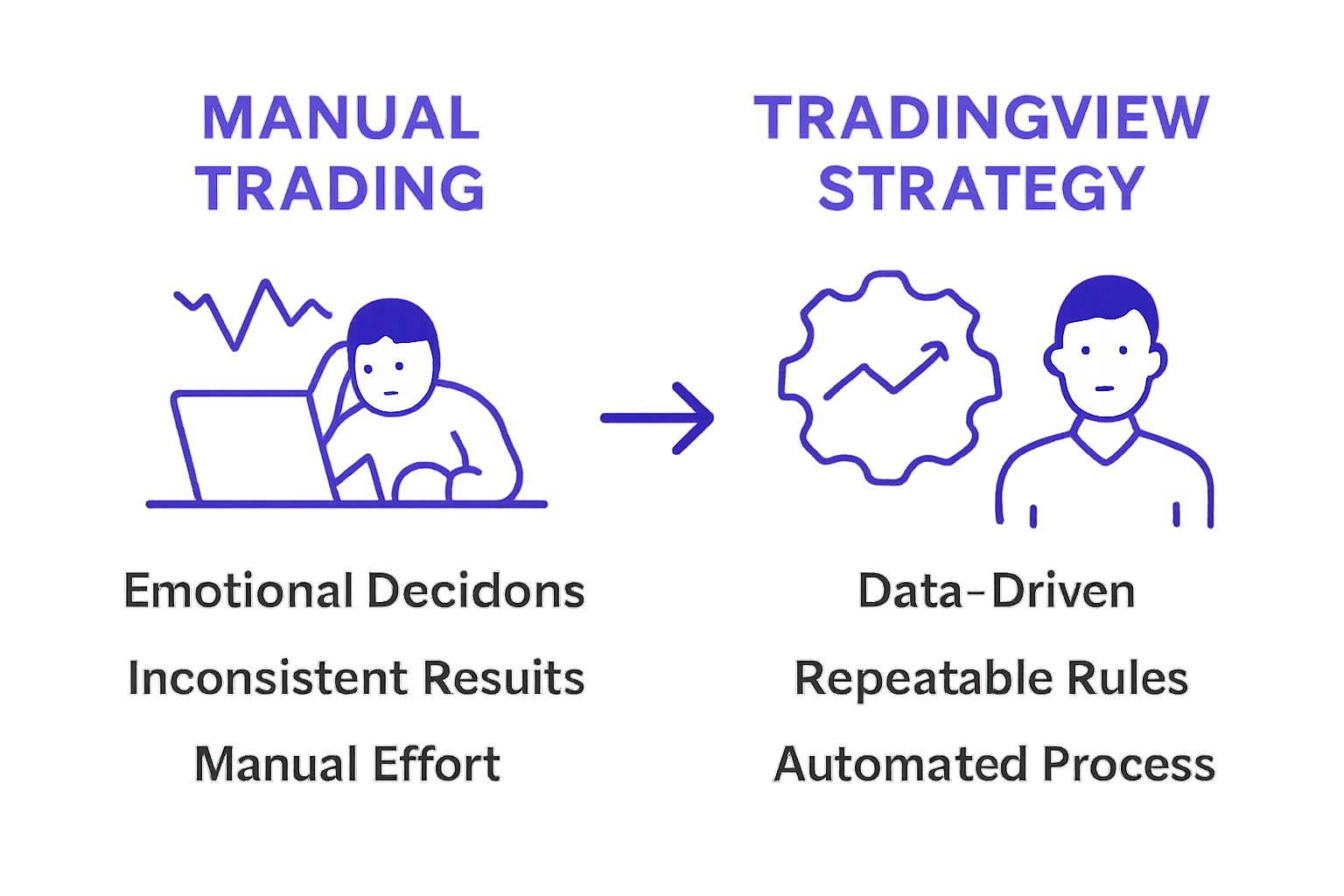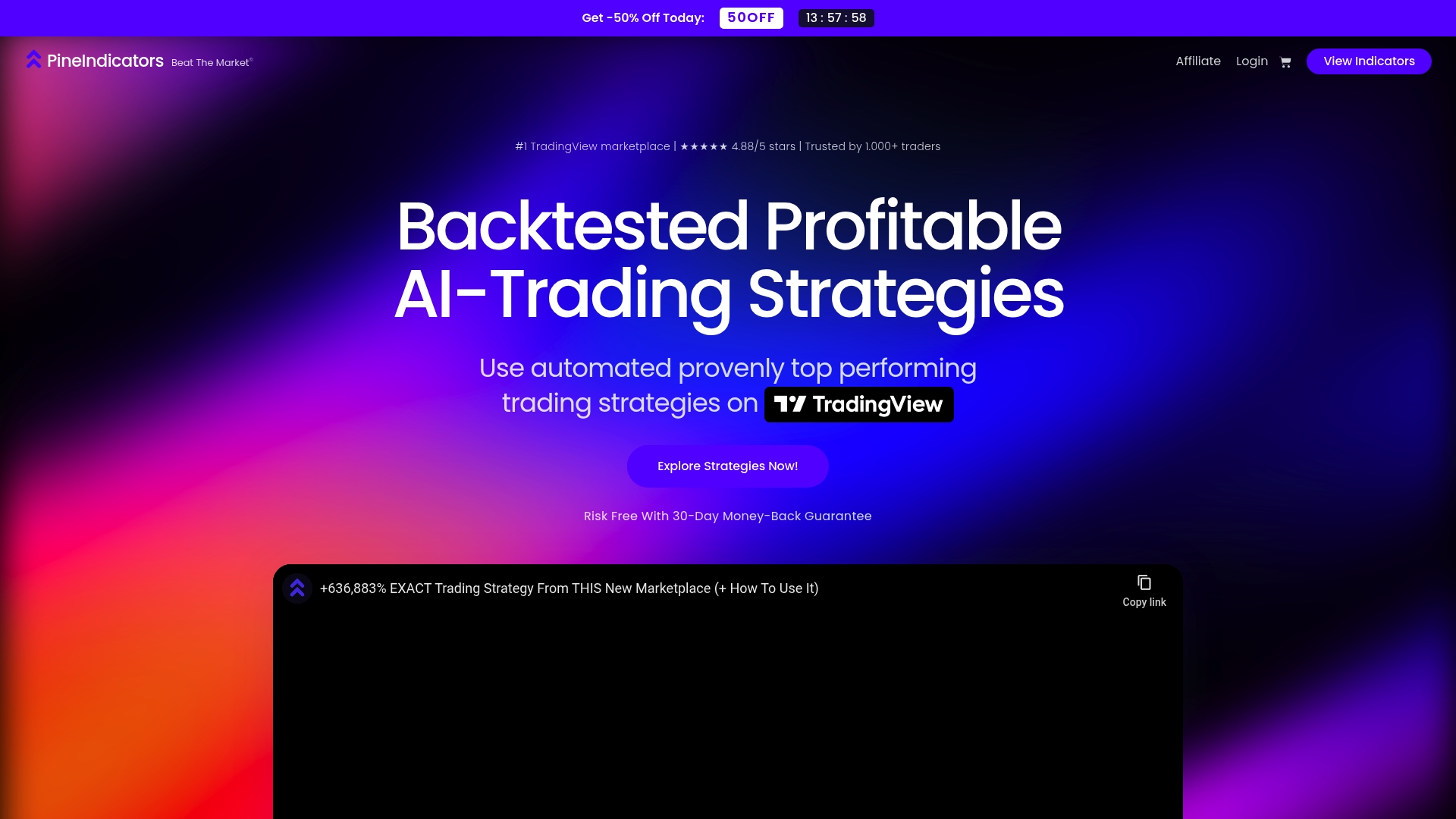Get -50% Off Today:
50OFF
:
:
Get -50% Off Today:

TradingView strategies change the way traders approach the market. Some traders still rely on gut feelings or basic chart watching, but the best actually use systems that crunch numbers and process information faster than any human ever could. Sophisticated TradingView strategies can sift through millions of data points in seconds, giving traders a huge edge that feels almost futuristic. This opens the door to techniques that seem out of reach but are available to anyone willing to learn.
| Takeaway | Explanation |
|---|---|
| TradingView strategies automate trading decisions | They use technical indicators and predefined rules to minimize emotional biases in trading. |
| Pine Script enables complex strategy development | This proprietary programming language allows traders to implement intricate trading algorithms effectively. |
| Consistent rule adherence reduces errors | Adhering to systematic strategies helps traders make more disciplined decisions without emotional influences. |
| Data-driven analysis improves trading accuracy | The integration of multiple analytics enhances the potential for identifying profitable trading opportunities. |
| Risk management is essential for success | Establishing predefined limits helps protect capital and control potential losses in volatile markets. |
A TradingView strategy represents a sophisticated approach to financial market analysis that combines technical indicators, trading rules, and automated decision-making processes within the TradingView platform. These strategies enable traders to develop systematic methods for entering and exiting trades based on predefined mathematical criteria and market conditions.
At its fundamental level, a TradingView strategy consists of several critical elements that transform raw market data into actionable trading signals. These components work together to create a comprehensive trading approach:
The table below summarizes the core components of a TradingView strategy and provides concise explanations for each, helping clarify their distinct roles in automated trading.
| Component | Explanation |
|---|---|
| Technical Indicators | Mathematical calculations based on historical price and volume data |
| Entry and Exit Rules | Specific conditions that determine when to buy or sell an asset |
| Risk Management Parameters | Predefined limits that control potential losses and protect trading capital |
| Pine Script | Proprietary TradingView programming language for implementing custom strategy logic |
| Automated Decision-Making | Logic-driven processes that remove emotional bias and execute trades based on set criteria |
Traders can construct these strategies using Pine Script, TradingView’s proprietary programming language. This language allows for intricate strategy development, enabling users to translate complex trading concepts into executable code that can analyze market movements with precision.
Understanding TradingView strategies goes beyond simple chart analysis. They represent a systematic approach to trading that removes emotional decision-making and replaces it with logical, data-driven processes. By developing comprehensive trading strategies, traders can create repeatable frameworks that potentially minimize human error and optimize trading performance.
Successful TradingView strategies typically incorporate multiple layers of analysis, including trend identification, momentum assessment, volatility measurement, and statistical probability calculations. These multifaceted approaches allow traders to develop robust systems that can adapt to various market conditions and asset classes, from stocks and forex to cryptocurrencies and indices.
While no trading strategy guarantees absolute success, well-constructed TradingView strategies provide traders with structured methodologies for approaching financial markets, transforming unpredictable trading landscapes into more manageable and potentially profitable environments.
TradingView strategies represent a transformative approach to financial market engagement, offering traders sophisticated tools to navigate complex and volatile trading environments. Unlike traditional manual trading methods, these strategies leverage advanced computational techniques to analyze market dynamics with unprecedented precision and efficiency.
One of the most critical advantages of TradingView strategies is their ability to remove emotional bias from trading processes. Human traders are inherently susceptible to psychological challenges such as fear, greed, and impulsive decision-making, which can significantly compromise trading performance. Best entry and exit strategies help traders implement systematic approaches that strictly adhere to predefined rules, ensuring decisions are based on objective mathematical criteria rather than fleeting emotional responses.
The systematic nature of these strategies provides several key benefits:

According to machine learning research in trading applications, algorithmic strategies can process vast amounts of market data far more quickly and accurately than human traders. These strategies integrate multiple analytical layers, including trend identification, momentum assessment, and statistical probability calculations, enabling traders to develop robust systems adaptable across various market conditions.
Modern TradingView strategies leverage advanced computational techniques to transform raw market data into actionable insights. By utilizing complex algorithms and real-time data processing, traders can identify potential trading opportunities with greater speed and accuracy, ultimately improving their potential for consistent market performance.
While no trading strategy guarantees absolute success, TradingView strategies represent a sophisticated approach to financial market participation. They provide traders with structured, data-driven methodologies that can potentially mitigate risks, optimize decision-making processes, and create more predictable trading frameworks in an inherently unpredictable market landscape.
TradingView strategies operate as sophisticated computational frameworks that transform complex market data into actionable trading signals through systematic algorithmic analysis. These strategies function by continuously processing multiple layers of financial information, creating a dynamic approach to market interpretation that goes far beyond traditional trading methodologies.
At the core of TradingView strategies lies an intricate process of signal generation that involves multiple analytical components. These strategies utilize Pine Script to create complex mathematical models that evaluate market conditions across different timeframes and asset classes. Enhance your trading strategies by understanding how these systems generate precise entry and exit points based on predefined computational rules.
The signal generation process typically encompasses several critical steps:
According to computational trading research, advanced algorithmic strategies demonstrate remarkable capabilities in adapting to rapidly changing market conditions. These strategies incorporate sophisticated risk management protocols that dynamically adjust trading parameters based on real-time market volatility and performance metrics.
Unlike human traders, TradingView strategies can simultaneously analyze multiple market variables, including price momentum, trend strength, volatility indices, and statistical probability calculations. This multidimensional approach enables traders to develop robust systems capable of identifying potential trading opportunities across diverse financial instruments such as stocks, cryptocurrencies, forex, and indices.
The computational nature of these strategies allows for unprecedented precision in market analysis. By eliminating emotional decision-making and replacing it with data-driven algorithmic processes, TradingView strategies provide traders with a systematic approach to navigating complex and often unpredictable financial markets. While no strategy guarantees absolute success, these advanced computational frameworks represent a significant evolutionary step in modern trading technology.
Developing robust trading strategies requires a comprehensive understanding of complex market dynamics, computational techniques, and systematic risk management. Successful strategy development goes beyond simple technical analysis, demanding a multifaceted approach that integrates mathematical modeling, behavioral insights, and advanced technological capabilities.
Effective trading strategies are built upon several critical foundational elements that transform raw market data into actionable trading insights. Understanding custom trading strategies involves recognizing the intricate balance between quantitative analysis and strategic framework design.
The fundamental components of a well-constructed trading strategy include:
This table organizes foundational elements required for developing effective TradingView strategies, summarizing the essential focus of each component for easy comparison and practical understanding.
| Foundational Component | Focus Area |
|---|---|
| Market Context Analysis | Understanding specific market characteristics and behaviors |
| Risk Tolerance Quantification | Establishing precise risk management parameters |
| Performance Metrics Definition | Creating clear benchmarks for strategy evaluation |
| Computational Logic Development | Designing algorithmic decision-making processes |
According to computational trading research, the validation of trading strategies requires rigorous testing methodologies that extend far beyond traditional analytical approaches. Modern strategy development emphasizes comprehensive backtesting, which involves simulating trading decisions against historical market data to assess potential performance and identify potential weaknesses.
The validation process encompasses multiple sophisticated analytical techniques, including:
Successful trading strategy development demands a nuanced understanding of market complexity. Traders must recognize that no single strategy represents a universal solution, but rather a dynamic framework that requires continuous refinement and adaptation. The most effective strategies integrate advanced computational techniques with deep market understanding, creating flexible systems capable of navigating diverse and unpredictable financial landscapes.

You have learned how TradingView strategies help reduce emotional decision-making, enforce consistent rules, and use advanced data analysis to find real trading opportunities. But while building your own strategy takes time, effort, and technical skill, PineIndicators.com gives you instant access to proven, expert-built TradingView strategies and indicators.

Why struggle with untested or repainting scripts when you can use strategies that are fully backtested for up to 20 years and trusted by real traders? Start leveraging real-time, non-repainting strategies developed for TradingView and enjoy seamless setup, full support, and a risk-free 30-day money back guarantee. Visit PineIndicators.com now to unlock strategies you can add directly to your charts today. Give your trading the professional edge it deserves before your next trade.
A TradingView strategy is a systematic approach to financial market analysis that combines technical indicators, trading rules, and automated decision-making processes within the TradingView platform. It helps traders define entry and exit points based on mathematical criteria and market conditions.
To create a TradingView strategy, you can use Pine Script, TradingView’s proprietary programming language. This allows you to define technical indicators, establish entry and exit rules, and implement risk management parameters effectively.
The main components of an effective TradingView strategy include technical indicators, entry and exit rules, and risk management parameters. These elements work together to translate market data into actionable trading signals.
TradingView strategies minimize emotional trading decisions by adhering to predefined rules and automated processes. This systematic approach helps eliminate biases related to fear and greed, leading to more objective and consistent trading outcomes.
 pineindicators.com
pineindicators.com

Wait! Before your leave, don’t forget to…
OR copy the website URL and share it manually:
https://pineindicators.com/free